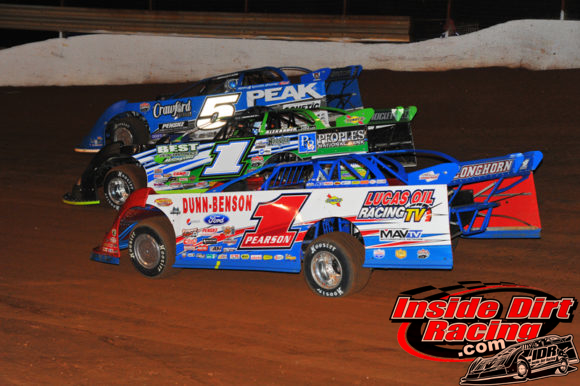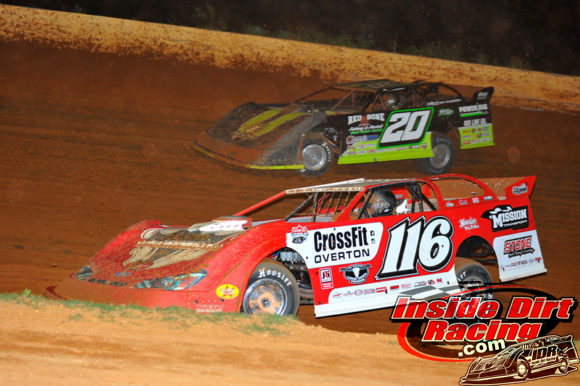
According to a recent poll question, drivers passing each other is by far the most important aspect of a good race
I first began writing about racing in a weekly NASCAR column for The Mountain Press newspaper in Sevierville, Tenn. back in 2008. Shortly after that I expanded to writing more frequently, first with a NASCAR themed website called RacingWithRich.com and then a dirt racing site called TennesseeRacer.com. More recently, I have partnered with Michael Moats here on InsideDirtRacing.com to primarily cover dirt racing. As a result of all that coverage, I have seen a lot of racing as a writer over the past decade combined with many years of attendance and viewership of races as a fan dating back to my childhood.
My point in offering that brief recount of my experience in the sport is to say that I thought I had an understanding of what fans like to see when they go to the track or when they turn on the television. Being a fan first and foremost myself, I know what I think the elements are that make up a “good” race as opposed to a “bad” race.
On almost a weekly basis, I take note of the Twitter poll questions posed by NASCAR writer Jeff Gluck(@Jeff_Gluck) in which he asks following each Monster Energy NASCAR Cup Series event whether or not his followers thought they had just seen a good race. For the most part it seems as if fans grade races favorably in these queries. However, the recent Monster Energy NASCAR All-Star race held at Charlotte Motor Speedway won by Kyle Busch proved to be a resounding flop in Gluck’s poll with a mere 18% of the respondents calling it a good race.
That said, I decided to involve fans in a recent Twitter poll of my own to see what they like and what they don’t like regarding racing. What does make a race “good” or “bad”?
I have always been under the impression, and this goes back to the days in which I followed NASCAR more closely, that fans determined whether they liked a particular race based on who won. Since Kyle Busch is not exactly the most popular guy in NASCAR, it would seem like a logical assumption to say that fans offered such disdain for the All-Star event because he won.
Conversely, I would have guessed that fans might view a race won by the highly popular Dale Earnhardt, Jr. as being a good one even if proved to be completely lacking in excitement and action.
Further, I have always assumed that there were at least some out there who watch racing in hopes of seeing some carnage. Those folks, I would have guessed, might consider a Talladega event that featured one or two of ‘The Big One’ type accidents to be high on their entertainment scale.
However, the poll I conducted did not support either of those theories at all.
My Twitter question asked, “If you label a race as a dud, what’s the biggest reason?” The answer choices were: 1. No passing, 2. No wrecks, 3. The wrong guy won.
By an overwhelming margin, the answer “No passing” was the winner. Fully 94% selected that choice with only 3% choosing “No wrecks” and the remaining 3% going with “The wrong guy won”. A total of 359 followers participated in the highly unscientific poll.

Side-by-side action appears to be more important to fans than crashes or even the ultimate winner of the race
Based on these results, fans clearly want to see passing. Words such as “train race” and “follow the leader” came up as words of disdain in the responses I received along with my question. So, it would seem essential for those who make the rules in all forms of racing to create the best possible atmosphere for the exchanging of positions to take place throughout a race.
Furthermore, it appears as if the fan who may dislike a racer such as Scott Bloomquist, Josh Richards or any other driver can accept a victory by that person if the overall race featured plenty of mixing it up along the way. And even if the race ran caution free with no incidents to make the highlight videos, it can still be considered a good show in the eyes of an overwhelming number of fans as long as some passing occurs.
NASCAR has seemingly struggled with this for years. As far back as the 1990’s, and perhaps even earlier, the term “aero-tight” became part of the common lingo for that form of the sport. Aero-tight refers to a condition in which a trailing car finds itself in the wake of dirty air stirred up by the leading car and thus develops a tight, or pushing, condition. That, in turn, leads to the car’s inability to close in on and ultimately pass the front running car.
This condition, according to drivers at the time, was made worse when NASCAR introduced the ‘Car of Tomorrow’ during the 2000’s as its primary machine design for the top division. More recent changes to body designs seemed to have helped some, but the races held on the so-called cookie cutter tracks continue to experience a lack of passing under green flag conditions.
In one of our recent ‘Turn 2 Blog‘ pieces, Michael and I discussed the frequency with which the phrases “led flag-to-flag” and “led all the way” are being used in dirt racing in recent years. As drivers and teams work to make the bodies of the cars sleeker and sleeker, the passes on the track seem to become fewer and fewer.
Is dirt racing heading in the same direction as NASCAR in that the cars have become too good for their own good?
Granted, dirt racing has a couple of significant advantages over pavement racing that can enhance passing. First, track preparation is still a major determining factor in the level of competition. Unlike asphalt or concrete tracks which offer more consistency of the racing surface, dirt tracks can change drastically from week-to-week or even day-to-day. Based on the many factors that go into the massaging of the clay, a track that may lock down and offer little passing during one particular race may provide two-groove action aplenty the next week.
Another distinct difference between dirt racing and pavement racing that allows for more passing is the dirt racer’s greater ability to use the ‘slide job‘ pass on his/her competitors. This type of maneuver calls for a driver to accelerate deeper into a turn than his/her rival then allow the car to slide up the track in front of the other car. This pass is not as easily done on pavement since the cars do not slide as well on that type of surface.
Still, I have had several drivers explain to me the feeling they get when trailing behind another car in terms of what the air can do to the handling of the trailing machine. In many respects, their descriptions sound very similar to those we often hear during the broadcast of a NASCAR race.
Dirt Late Model now speak of the air getting taken off the nose of their cars and the car getting too tight in traffic, just like NASCAR racers do. Sometimes the condition of the track and the ability to enact a slide job is not enough to overcome the aerodynamics of the modern-day bodies.
The bottom line in all of this is that fans want to see drivers pass each other on the race track and when that doesn’t happen, they are more apt to label a race as “bad”. And too many of those bad races will eventually result in them not coming back to the track or not turning on the television on race day. That’s not good for promoters, drivers, teams, sponsors or anyone else.





